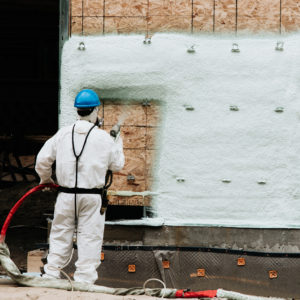Modern Energy Efficiency
Foam plastic insulation products for residential and commercial buildings are modern materials that are made of a variety of plastics, including polyisocyanurate, polystyrene and polyurethane. They help architects, contractors and other construction professionals meet today’s stringent energy code standards for both new construction and renovation projects while offering other performance advantages that enhance durability and resiliency.
Foam plastic insulation products are available in rigid boards and as spray-applied products. They are durable, energy-efficient and versatile. They can insulate and effectively seal gaps, close off air leaks and serve as barrier materials for moisture to help maintain indoor comfort and improve a building’s energy performance. When used in walls, roofs and below-grade, insulation products are an integral part of the assembly of materials that makes up the building envelope.
 Why Does an Efficient Building Envelope Matter?
Why Does an Efficient Building Envelope Matter?
- Properly insulating and air-sealing a home can save homeowners up to 50 percent on heating and cooling costs, according to the U.S. Department of Energy (DOE) and U.S. Environmental Protection Agency (EPA).
- The U.S. DOE found that in commercial construction, new buildings can achieve a 50 percent energy savings when a variety of energy-efficient design elements, such as continuous rigid foam plastic insulation products, are incorporated into the project rather than standard or typical construction materials and methods
- Using continuous insulation can eliminate thermal heat loss, saving 20-70% of heat flow through building walls over and above an equivalent R-value of cavity insulation.
- The NIBS 2019 Natural Hazard Mitigation Saves Report has found that “adopting the latest building code requirements is affordable and saves $11 per $1 invested.” Building codes have greatly improved society’s disaster resilience, while adding only about 1% to construction costs relative to 1990 standards. The greatest benefits accrue to communities using the most recent code editions. These modern codes include insulation and air sealing that provide passive thermal resistance and help protect homeowners from extreme heat and cold temperatures.
Why is a foam plastic insulation product an energy-efficient choice?
- High R-value per inch of thickness. R-value measures the ability of insulation to resist the flow of heat. Foam plastic insulation materials typically provides higher R-value per inch traditional materials Additionally, when installed as continuous insulation it mitigates thermal bridging and significantly boosts the effectiveness of the insulation system. Always consult manufacturer data sheets for information on specific product R-values.
- Easy to install. Foam plastic insulation products are available to insulate and air seal almost any part of a building, from the roof, to the walls, to the foundation. These products are light weight and often eliminate the need for an additional air barrier or water resistive barrier saving money and labor.
- Creates air barriers. Sealing a building with foam plastic insulation and air sealing product helps reduce drafts and allows more control over indoor temperature, which can lower energy use and make the home more comfortable
- Creates moisture barriers. Properly managing moisture transmission and accumulation is essential to the performance, health and durability of buildings. Keeping moisture out of walls reduces the chances of mold and mildew growth and protects indoor air quality.
- A critical tool. Used by designers to reduce thermal bridging, a significant source of energy loss.
- Durable. When properly installed, foam plastic insulation products can perform for the life of the building in wall and below-grade applications. Roof insulation provides excellent performance for the life span of the roof assembly system.

